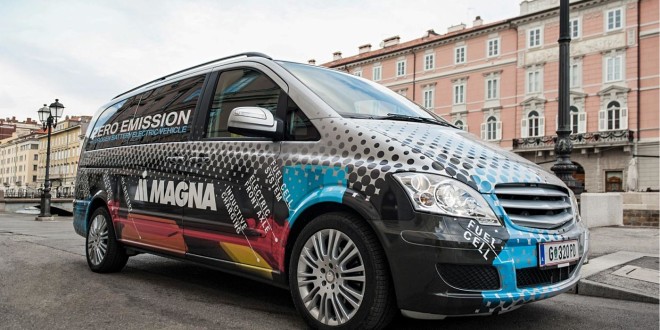Magna International, the Canadian contract automotive manufacturers, is set to break the ‘rules’ as automakers continue the search for a clean source of energy, with members of the Hydrogen Council taking the lead in the exploration of hydrogen-based energy while a few others are already exploring the great potential in electric vehicles.
With the challenges of recharging batteries for electric vehicles and enough hydrogen facility for fuel-cell vehicles already identified for the two energy sources of the future, Magna, according to Automotive News Canada, has come out with it called the fuel cell range-extended electric vehicle (FCREEV) concept, as a temporary solution .
The minivan, powered by the two sources of clean energy, was one of the revelations at the ongoing Geneva Motor Show in Switzerland. Automotive News Canada reports that the FCREEV concept, built by the company’s subsidiary , Magna Steyr in Austria, is a debadged Mercedes Viano minivan packing a smaller-than-average fuel-cell to recharge its battery on the move, stressing that this comes in handy as a stop-gap before “long-range electric cars can speed up recharging and/or a proper hydrogen refuelling network is built.”
Project leader, Helfried Mueller, who is the head of alternative propulsion systems in Magna’s Austrian r&d,told Automotive News Canada on the sidelines of the Geneva motor show, that “There’s a big potential for this type of vehicle in the near future,” even as Magna disclosed that “one potential customer for the vehicle,” which range is 350 km (217 miles), about 70 km of which can be on battery power alone, “could be urban delivery companies, forced in the future to use zero emission vehicles, but lacking time to recharge batteries.”
However, its range, which is 350 km (217 miles), about 70 km of which can be on battery power alone, and the fuel-cell stack which is rated at 30 kWh, fall short of the 114 kWh in the Toyota Mirai fuel-cell vehicle, according to Automotive News Canada.
“Because the FCREEV’s fuel-cell stack is smaller and because it works as a battery recharger rather than a primary power source, it’s cheaper than a standard stack. It’s still too expensive however. Mueller estimates even if Magna scaled up production to 500,000, it would still cost 20-30 per cent more than an equivalent diesel engine. The cost of the 16 kWh lithium ion battery pack is on top of that.
“Magna has no plans for production but instead is using the FCREEV as a mobile shop front for its skills, including product engineering, producing elements of the electric drivetrain and contract manufacturing. The fuel cell stack itself is made by Proton Motor, “ Automotive News Canada said.
 ..:: AUTO REPORT AFRICA ::..
..:: AUTO REPORT AFRICA ::..




